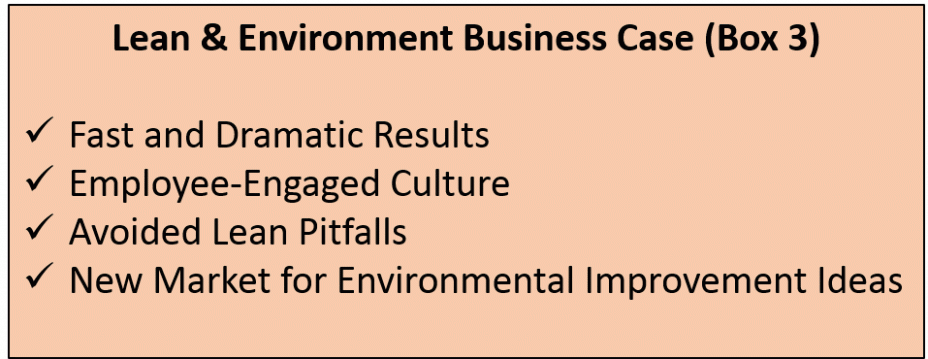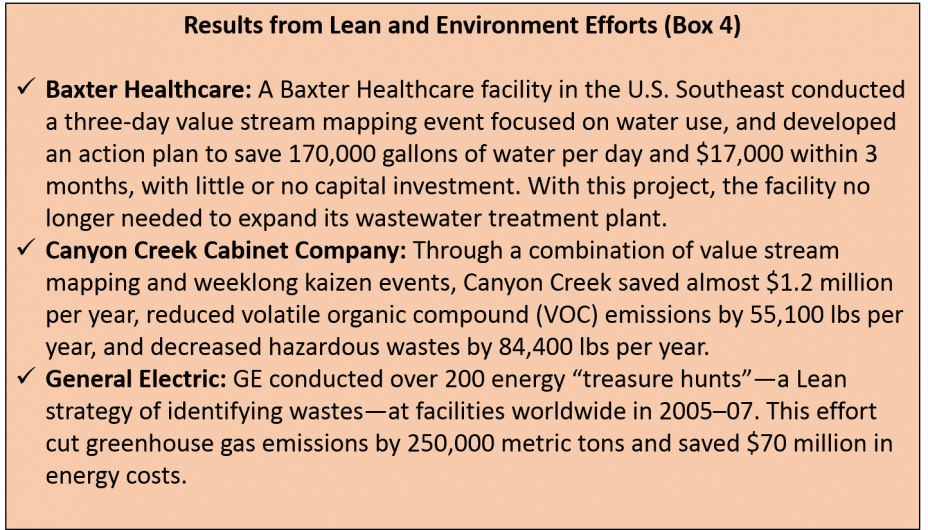Environmental Professional’s Guide to Lean and Six Sigma: Chapter 1
Why Lean and Six Sigma Are Important to the Environment
- Much Progress but More Opportunity
- Leveraging Operational Process Improvement Efforts
- The Lean and Environment Business Case
- Toolkit Navigation
Over the past few years, many environmental professionals have watched the rapid expansion of Lean and Six Sigma activities sweeping across diverse commercial and manufacturing sectors. A growing number of environmental professionals see an exciting opportunity to leverage this trend to achieve better environmental results more quickly.
This chapter discusses this trend and explores why environmental professionals might want to learn more about and connect with Lean and Six Sigma initiatives. The chapter explores how connecting Lean and Six Sigma process improvement efforts with environmental initiatives can advance both efforts, delivering environmental and sustainability results faster. The challenge, and opportunity, for environmental professionals is to productively engage with Lean and Six Sigma practitioners—meeting them where they are; to translate environmental opportunities and concepts into the Lean and Six Sigma lexicon; and to make environmental improvement a seamless, integrated aspect of delivering value to meet customers’ needs.
Much Progress but More Opportunity
Dramatic progress has been made during the past twenty years in commercial and industrial sector environmental management. Focus on end-of-pipe clean-up and regulatory compliance has expanded to preventing pollution at its source and considering broader environmental sustainability objectives in organizational decisions. Environmental professionals have enabled this transition. The results attributed to environmental management, pollution prevention (P2), and environmental sustainability initiatives are impressive. Advances in four key areas are helping organizations across diverse sectors realize compelling environmental and economic results:
- Environmental tools and expertise help businesses and other organizations minimize waste, prevent pollution, and move towards more environmentally sustainable processes and products.
- Environmental management systems (EMS) institutionalize environmental management activities and foster continual improvement.
- The business case for environmental activities influences an increasing number of business decisions, as case studies and analysis demonstrate the benefits proactive environmental management can have on bottom line performance.
- Businesses are increasingly experimenting with “paths to sustainability” incorporating corporate social responsibility and “triple bottom line” thinking into the core fabric of business strategy and operations.
Despite the progress, there is still significant opportunity to improve environmental performance - further reducing the environmental footprint of production processes, products and services.
Given the numerous environmental and economic benefits of environmental initiatives - such as EMS, pollution prevention, design for environment, and other environmental and sustainability initiatives - one might expect that it would be easy to get companies to implement more environmental efforts. Typically, however, these initiatives have a difficult time competing in the corporate culture.
One misconception that environmental professionals sometimes have is that if more people knew about the benefits of environmental opportunities, organizations would do more. An obvious implication of this argument is to invest in more information diffusion and technical assistance. If we could only get the wealth of environmental management tools that exist into the right hands, more would be done. While this thinking is clearly important, there is reason to suspect there is more to the story.
A well known and documented study of pollution prevention activities at Dow’s Midland, Michigan chemical manufacturing plant found that the most common barrier to environmental and P2 project implementation is the internal competition for capital and management time and attention. A positive return on investment is not always sufficient - capital projects must clear internal hurdles that weigh the value of each alternative when using limited capital. Even small projects that require limited or no capital investment must compete for limited organizational time and attention. As a result, many promising ideas - environmental and other - end up on the cutting room floor because they are not viewed as central to business success.
This challenge has spurred many environmental professionals to seek creative ways to attract attention and organizational investment for environmental improvement opportunities. It is in this context that Lean manufacturing and Six Sigma have emerged as powerful vehicles for delivering environmental results. While it is not necessarily easy, initial results from leveraging Lean and Six Sigma business improvement methods to advance environmental goals are promising. Box 4 provides examples of how companies have obtained environmental results and saved costs by integrating environmental considerations into Lean projects.
Leveraging Operational Process Improvement Efforts
![]() Lean manufacturing refers to a collection of business improvement principles and methods, originally developed by Toyota, that focus on the systematic identification and elimination of non-value added activity or “waste” involved in producing a product or delivering a service to customers. Six Sigma, developed by Motorola and popularized by General Electric, refers to a method and set of quantitatively rigorous tools that utilize information and statistical analysis to measure and improve an organization’s performance, practices, and systems, with a primary goal of identifying and eliminating sources of variation. Lean and Six Sigma both incorporate a continuous improvement culture that is conducive to waste minimization and pollution prevention. Some companies place more emphasis on Lean, while others emphasize Six Sigma as an organizing framework. Increasingly, organizations merge the methods as “Lean Six Sigma.”
Lean manufacturing refers to a collection of business improvement principles and methods, originally developed by Toyota, that focus on the systematic identification and elimination of non-value added activity or “waste” involved in producing a product or delivering a service to customers. Six Sigma, developed by Motorola and popularized by General Electric, refers to a method and set of quantitatively rigorous tools that utilize information and statistical analysis to measure and improve an organization’s performance, practices, and systems, with a primary goal of identifying and eliminating sources of variation. Lean and Six Sigma both incorporate a continuous improvement culture that is conducive to waste minimization and pollution prevention. Some companies place more emphasis on Lean, while others emphasize Six Sigma as an organizing framework. Increasingly, organizations merge the methods as “Lean Six Sigma.”
Lean and Six Sigma process improvement methodologies work well together. Lean’s focus on eliminating waste and improving speed of processes is complemented with Six Sigma’s focus on eliminating variation and improving product quality. Box 5 provides a comparison of Lean and Six Sigma.
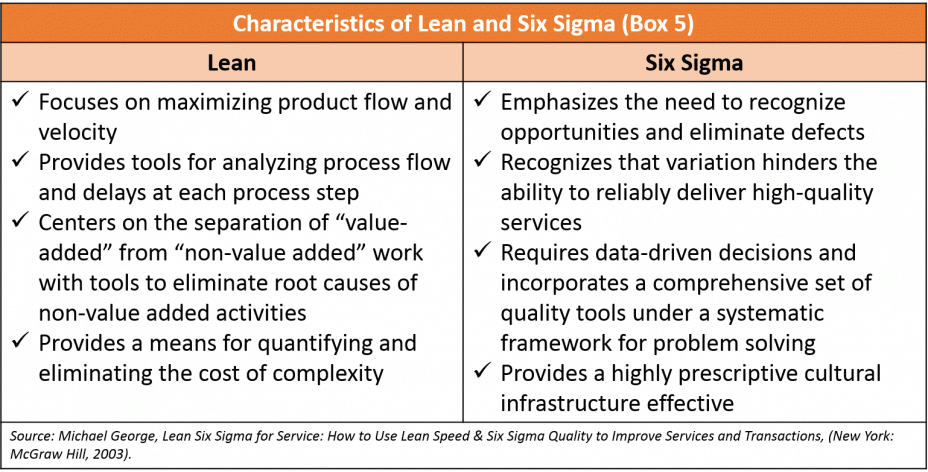
![]() Lean and Six Sigma have legs. Businesses, organizations, and government agencies are aggressively expanding the use of Lean and Six Sigma as core strategies for addressing competitive market pressures affecting cost, quality, and customer demands. Lean is driving change in numerous commercial and industrial sectors, ranging from automotive, aerospace, and metal finishing to health care, construction, and wood products. Lean’s bias towards action and rapid improvement creates staying power which helps Lean avoid a reputation as a flavor of the month. Even while commitment to Lean and Six Sigma varies significantly across organizations, many view implementation as a long-term journey that will require sustained leadership and organizational commitment.
Lean and Six Sigma have legs. Businesses, organizations, and government agencies are aggressively expanding the use of Lean and Six Sigma as core strategies for addressing competitive market pressures affecting cost, quality, and customer demands. Lean is driving change in numerous commercial and industrial sectors, ranging from automotive, aerospace, and metal finishing to health care, construction, and wood products. Lean’s bias towards action and rapid improvement creates staying power which helps Lean avoid a reputation as a flavor of the month. Even while commitment to Lean and Six Sigma varies significantly across organizations, many view implementation as a long-term journey that will require sustained leadership and organizational commitment.
![]() Lean and Six Sigma can effectively complement environmental initiatives. Environmental professionals have long contended that to make sustained environmental improvement that moves beyond “low-hanging fruit,” an organization must create a continual improvement-focused waste elimination culture. Common elements of this organizational culture, as identified in many environmental initiatives, include:
Lean and Six Sigma can effectively complement environmental initiatives. Environmental professionals have long contended that to make sustained environmental improvement that moves beyond “low-hanging fruit,” an organization must create a continual improvement-focused waste elimination culture. Common elements of this organizational culture, as identified in many environmental initiatives, include:
- A systematic approach to continual improvement
- A systematic and on-going effort to identify, evaluate, and eliminate waste and environmental impacts that is embraced and implemented by operations personnel
- Environmental metrics that provide performance feedback
- Engagement with the supply chain to improve enterprise-wide performance
Lean and Six Sigma seek to create a very similar, and highly complementary, organizational culture focused on continual improvement. In doing so, they use tools that are similar to many used by environmental professionals, such as visual mapping of processes and root cause analysis.
By connecting environmental initiatives with Lean and Six Sigma deployment efforts, environmental professionals can help environmental improvement ideas compete more effectively and embed them in culture-changing process improvement practices. When the plant floor is being reconfigured and operations are being changed through Lean Six Sigma, the marginal cost of incorporating environmental improvement ideas is low. Box 6 lists some labels that have been used to describe efforts that integrate environmental considerations into Lean and Six Sigma activities.
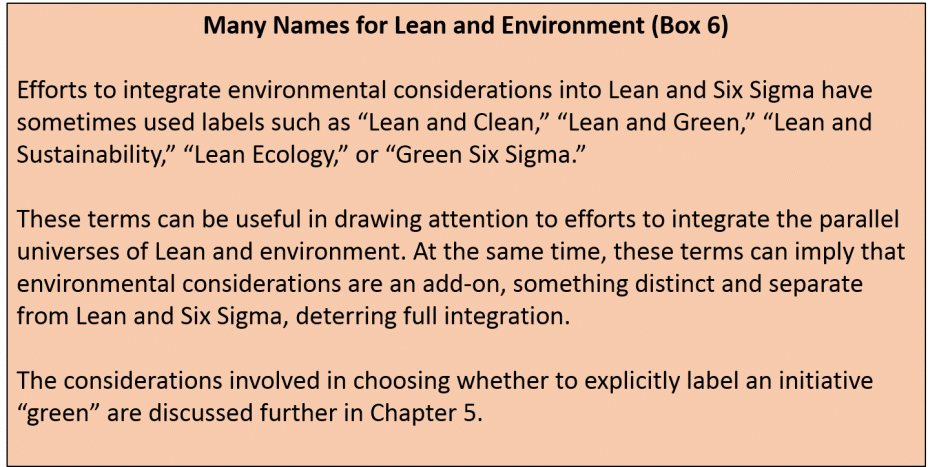 The key is to get environmental improvement ideas and knowledge into the hands of Lean teams at the point where operational change decisions are being made. Environmental improvement ideas do not need to compete independently; they can ride the coattails of Lean and Six Sigma implementation, Box 7 talks about one company’s experience. Real world experience demonstrates that this “Lean and environment” collaboration benefits both operational and environmental outcomes.
The key is to get environmental improvement ideas and knowledge into the hands of Lean teams at the point where operational change decisions are being made. Environmental improvement ideas do not need to compete independently; they can ride the coattails of Lean and Six Sigma implementation, Box 7 talks about one company’s experience. Real world experience demonstrates that this “Lean and environment” collaboration benefits both operational and environmental outcomes.
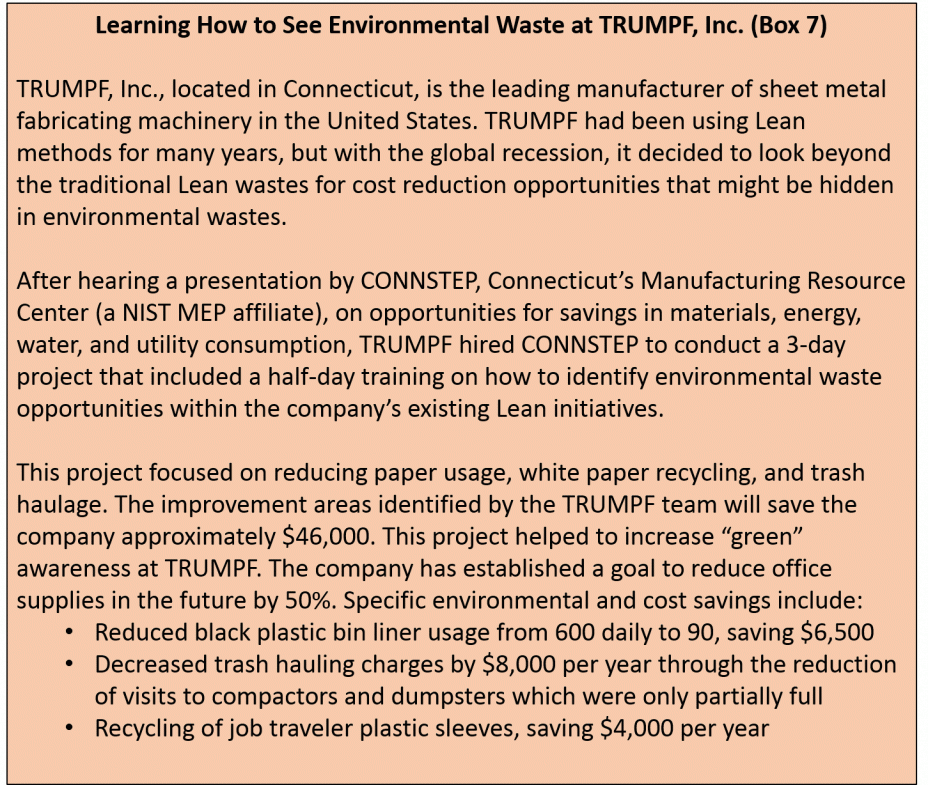 Lean and Six Sigma are not replacements for environmental management approaches and tools, but powerful delivery mechanisms.
Lean and Six Sigma are not replacements for environmental management approaches and tools, but powerful delivery mechanisms.![]() As organizational improvement tools, they have the potential to connect environmental management concepts with a rapid implementation setting where critical business decisions are being made. Lean and Six Sigma do not focus on process improvement alone. In addition to process improvement, Lean and Six Sigma can be applied to product design by using methods such as Production Preparation Process (3P) and Design for Lean Six Sigma. The challenge, and opportunity, is to harness the collection of Lean and Six Sigma methods to drive environmental improvement and sustainability ideas deep into core business strategy and operations. Lean and Six Sigma are means, while zero waste and sustainability are goals. These goals fit well with Lean’s focus on identifying and eliminating non-value added activity.
As organizational improvement tools, they have the potential to connect environmental management concepts with a rapid implementation setting where critical business decisions are being made. Lean and Six Sigma do not focus on process improvement alone. In addition to process improvement, Lean and Six Sigma can be applied to product design by using methods such as Production Preparation Process (3P) and Design for Lean Six Sigma. The challenge, and opportunity, is to harness the collection of Lean and Six Sigma methods to drive environmental improvement and sustainability ideas deep into core business strategy and operations. Lean and Six Sigma are means, while zero waste and sustainability are goals. These goals fit well with Lean’s focus on identifying and eliminating non-value added activity.
The Lean and Environment Business Case
![]() For environmental professionals, the fundamental value of integrating Lean and environment efforts is to get more environmental results faster. Four compelling reasons support the business case for Lean and environment:
For environmental professionals, the fundamental value of integrating Lean and environment efforts is to get more environmental results faster. Four compelling reasons support the business case for Lean and environment:
- Fast and Dramatic Results: Lean produces change and results fast. Kaizen rapid improvement events identify waste and implement solutions in less than a week. When environmental issues are integrated into Lean activities, companies have seen quick and compelling environmental results. Without proper attention, however, Lean’s focus on immediate implementation can sometimes conflict with permitting requirements for environmentally sensitive processes (see Chapter 4 for more information). This is an important reason for environmental professionals to be involved.
- Continual Improvement Culture: Lean and Six Sigma tools—such as value stream mapping (VSM), kaizen events, 5S, standard work, visual controls, and total productive maintenance—engage personnel throughout an organization in identifying and eliminating Lean wastes. Leveraging these tools can make environmental professionals’ jobs easier, reinforcing roles and responsibilities and breathing life into EMS implementation. The more eyes and ears there are seeing environmental wastes and improvement opportunities, the more progress can be made.
- Avoided Lean Pitfalls: While Lean and Six Sigma (without intervention by environmental professionals) can produce powerful environmental improvement results on its coattails, the rapid changes can also create environmental and regulatory compliance headaches. Lean and environment integration can help ensure adverse environmental impacts are avoided and navigate regulatory and permitting issues that may arise during Lean and Six Sigma driven changes.
- New Market for Environmental Improvement Ideas: Lean and Six Sigma practitioners are an important new audience for environmental improvement ideas and tools. By connecting with Lean and Six Sigma practitioners, environmental professionals can connect the wealth of environmental improvement ideas and tools with those who are driving strategic and operational change within many organizations.
The challenge, and opportunity, for environmental professionals is to figure out how to connect with Lean Six Sigma improvement efforts in a seamless way that embeds environmental considerations and sustainability concepts into the normal way of doing business. This guide is designed to assist environmental professionals in meeting Lean and Six Sigma practitioners where they are; help them translate environmental concepts into the Lean lexicon; and make environmental improvement efforts a seamless, integrated aspect of delivering waste-free value to meet customers’ needs.
The next two chapters provide more thorough descriptions of Lean and Six Sigma and subsequent chapters will describe the relationship between Lean, Six Sigma, and environmental initiatives.
Toolkit Navigation
- Contents & Acknowledgements
- Executive Summary
- Chapter 1: Why Lean and Six Sigma Are Important to the Environment
- Chapter 2: What Is Lean?
- Chapter 3: What Is Six Sigma?
- Chapter 4: How Do Lean and Six Sigma Relate to the Environment?
- Chapter 5: Why Does It Matter How We Talk About Lean and Environment?
- Chapter 6: Lean and Environment Applications
- Chapter 7: Conclusion
- Appendix A: Lean and Six Sigma Resources
- Appendix B: Lean and Environment Resources
- Appendix C: Lean and Six Sigma Glossary
- Appendix D: Environmental Glossary
- Appendix E: Summary of the Washington Lean and Environment Pilot Projects

